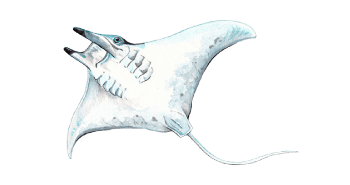
Giant Devil Ray
(Mobula mobula)
There are two genera of Devil Rays with very similar appearance. The smaller genus Mobula, include nine species with sizes ranging from 1 to 5 meters. The genus Manta includes 3 species with sizes up to 8 meters.
The Giant Devil Ray (Mobula mobular) is the largest species of the genus Mobula. Their natural enemies include big sharks and orcas. The rays can be seen alone or in little groups of 10-12 animals and, in general, they occur in the upper water layers, usually not much deeper as 20 meters.
General information
Further names: Portuguese: Mobula ; English: Devilfish
Size of adults: 3-5 m length
Prey: Plankton and small fish.
Life cycle and behaviour: Mobulas reach sexual maturity at a body length of about 4m. They possess a very low reproductive capacity and only give birth to a single pup at unknown intervals. Devil rays are live-bearing (ovovivipar) fish with females releasing fully-developed pups, which developed in their oviduct (they have no placenta like mammals) from fertilized eggs, that hatch inside the mother. Mobulas are the most active of all rays at the surface and often breach.
Habitat and range: Occurs throughout the Mediterranean Sea, and the Northeast Atlantic. It has been reported from the coast of northwest Africa (Morocco to Senegal), the Canary Islands, Madeira, the Azores, Portugal, rarely sightings off southern Ireland.
Distinctive features: Can be distinguished from other ray species by the wave=like movement onf their pectoral fins while swimming and are much smaller than Mantas. movements. They usually have a brown dorsal colour with two head fins on either side of their head. They often have ectoparasites, such as remoras, attached to their skin.
Taxonomy: Class: Chondrichthyes (Cartilaginous fish); Family: Myliobatidae (Eagle rays); Genus: Mobula rays
Threats: High bycatch mortality in many different fisheries, mainly in pelagic driftnets and dragnets. Are also massively caught in seine fishery in the Levantine Sea. Their slow reproductive capacity leads to a very slow recovery of populations, allowing them to be listed as endangered by the IUCN, especially in European waters.
